
Gasthof Shoneck’s living room.
What’s a ‘poshtel’ you ask? It may just be a gateway into a new form of travelling, where your accommodations aren’t just for sleeping–they’re for interacting, lounging, and connecting with other people. Hostels have been traditionally used as a way to save on funds while travelling, and a chance for solo travellers to meet new people. But the world of hostel is changing as the younger traveller changes too. For millennial travellers, a regular hostel just isn’t cutting it anymore and their need to be connected not just to people . Welcome to the world of ‘poshtels’… think of it as an upgraded version of a hotel, outfitted with the basic needs of a millennial traveller (i.e. what they’re accustomed to having on hand on a day-to-day basis). Netflix is on tap, the accommodations have to be cool, funky and hip, game rooms, clubs, places to lounge and network — all at affordable prices. We chatted with two leaders in the ‘poshtel’ trend David Meany, Director of Partner Marketing for The Travel Corporation and Toni Ambler, Brand Strategy Director for Contiki. They took on the task of renovating and redesigning a property in the middle of the Austrian mountains, the Gasthof Schoneck in Tyrol, Austria. And they may just sway you to reconsider everything you thought about where you stay while on vacation.
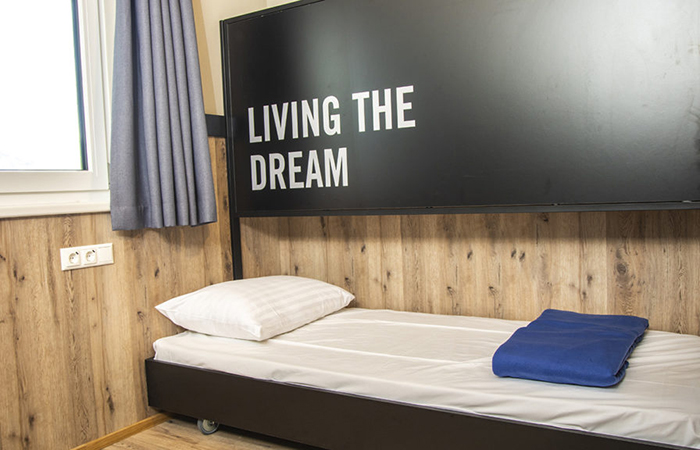
A bedroom at the Gasthof Shoneck.
When did the idea of ‘poshtels’ start or catch on?
“The idea of ‘poshtels’ really began to take notice in 2014-2015. At the time, hostels were seen as the ‘you get what you pay for’ type of accommodation among travellers. But more and more millennial travellers were looking for a middle ground between hotels and hostels and thus, ‘poshtels’ were born.”
What are the three key things that make a place a ‘poshtel’ versus a regular hostel?
“Firstly, the design aspect. What was once seen as just a place to sleep, ‘poshtels’ often occupy intriguing buildings and place an emphasis on cool, funky and laid-back designs that attract younger clientele. Whereas a hotel is often seen as more of an upscale, professional look and feel for older guests. In fact, more and more ‘traditional’ hotels are mimicking the ‘poshtel’ aesthetic.
Secondly, the social spaces on offer. ‘Poshtels’ feature game rooms, bars, restaurants, clubs, and rooftop bars. While many hotels offer similar amenities, the difference is in the cost – with ‘poshtels’ coming in at an affordable price.
Thirdly, ‘poshtels’ are now considered hot spots to hang out, drink, chill, eat, and network with other young travellers. As opposed to traditional hotels, ‘poshtels’ are not simply places to sleep.”
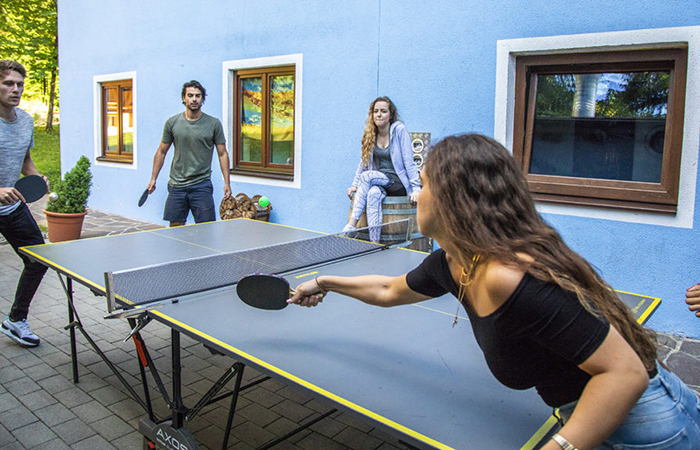
Gasthof Shoneck’s common areas help set it apart.
How did you go about updating the Gasthof Schoneck?
“The project began with site visits in July 2017, and in February 2018 the site turned into a building site just around the same time that the heavy snowfall and winter chills set in. It took us four months.”
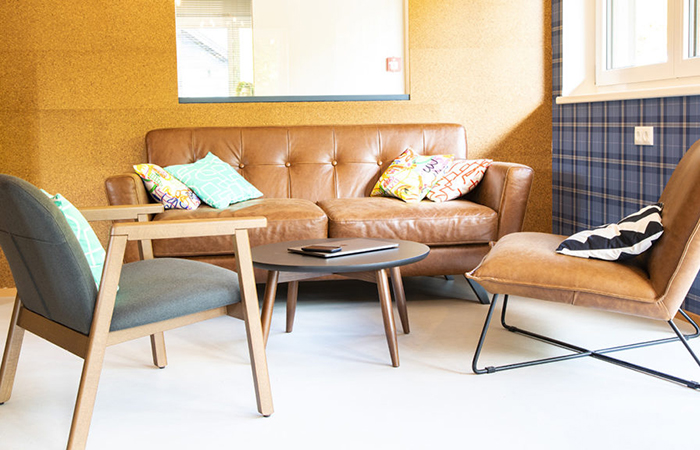
Gasthof Shoneck’s living spaces are cozy, interactive and perfect for networking.
What are some of the major upgrades you made?
“The common room was completely non-descript, uninviting and lacking in any personality. With the renovations, it’s now a home deco dream come true with plush sofas, a screen that’s just perfect for Netflix binges and quiet corners for Monopoly playing and card games for our guests.
The bedrooms. Our custom-made beds are designed in a way that allows the staff to easily alter the configuration of the room from double to twin or quad share. There is also ample storage space for suitcases and ski gear and importantly for millennials, we have USB PowerPoints throughout the building so our travellers can keep posting their shots on the ‘gram.
For the dining room, we worked with local suppliers to source materials and used a lot of wood to keep the cozy Austrian Gasthof feel with a particular favourite is our handmade Austrian wood tables for communal group dining that’s just perfect for our authentic and delicious Munch dining experiences. Think having traditional pork rosti and turkey schnitzel surrounded by other like-minded travellers from around the world in your Contiki group.”
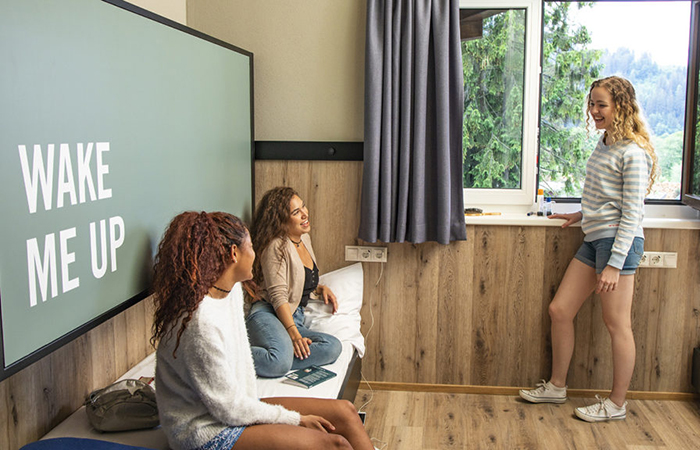
Gasthof Shoneck’s rooms take it up a notch in terms of hostels.
What influenced your decision to make these changes?
“Our inspiration came from trendy hotels – hotels and members only clubs that we ourselves hang out in across Europe. These are places where you come for a drink and end up staying all night. We wanted the space to feel like a home away from home where our guests can kick back and feel like a local.”
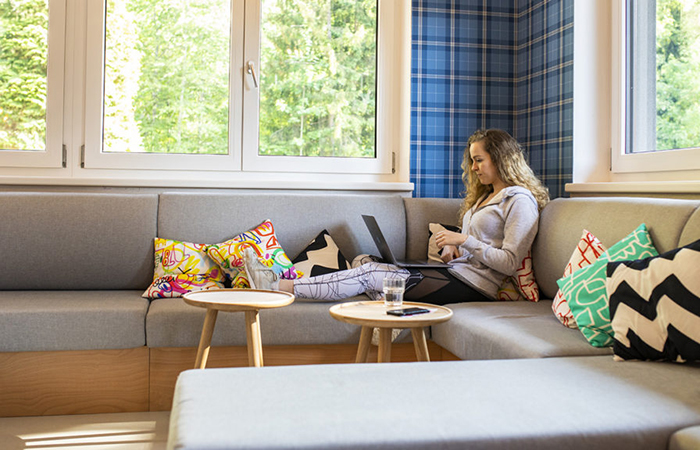
A cozy nook at the Gasthof Shoneck.
Why was the update important for millennial travellers?
“The update was important for Contiki to remain relevant with the millennial audience. This beloved chalet has been around since the 1970’s and although we kept it in good shape over the years, we realized that we needed to significantly overhaul it to ensure we meet the expectations of future travellers.”
What are millennial travellers looking for in terms of accommodations today?
“Personality, design that makes a statement, social spaces and above all, good and strong Wifi!”
Why do you think more millennial travellers are looking for accommodations like ‘poshtels’?
“There are many factors but one being that accommodation is a huge part of the travel experience and millennials don’t want that experience to end when they walk through the door. Traditional international hotel chains are not appealing to them as they all tend to look alike no matter where you are in the world. Millennials want local, unique and real experiences. ‘Poshtels’ are popular because they connect guests to the local destination and allow for social interaction with fellow travellers. Millennials simply want to meet new friends and explore together.”
More From Travel & Style:
An Insider’s Guide to Porto’s Coolest Neighbourhoods
Frequent Flyer Jillian Harris’s Packing Essentials
5 Tips for First Time Cruisers
The Top 5 Spas in Scottsdale, Arizona

